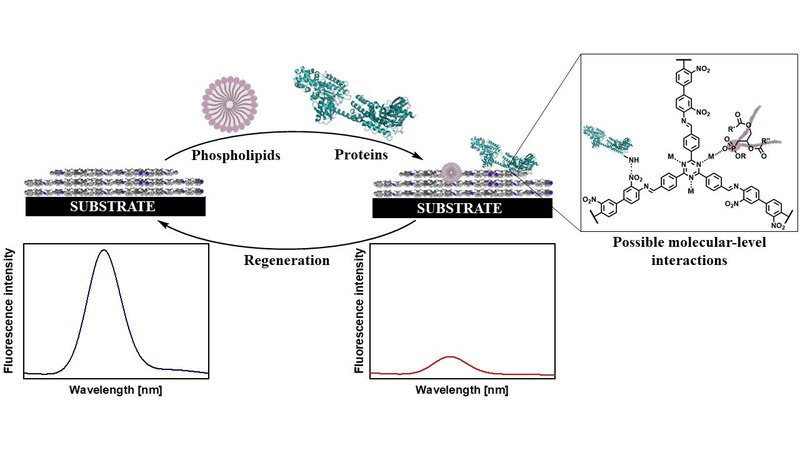Novel COF-based sensors for detecting organic agents in water
Project Content
Rapid detection of organic biological agents in water is crucial in disease prevention, yet it currently relies on costly and time-consuming biochemical, bacteriological and viral identification techniques. In this project, we aim to develop a novel chemical sensor to detect organic biological agents, such as phospholipids, proteins and bacterial cells, in an efficient manner. Taking into account the main researcher’s experience in the synthesis and characterization of covalent organic frameworks (COFs), we envision using this relatively new class of materials. Luminescent COFs will be constructed so that the target analytes will form either (i) coordination bonds with metallated centers of organic building blocks, which has been previously demonstrated by MRL in related monomeric systems, (ii) Meisenheimer complexes with free amines in proteins, or (iii) both of these two types of interactions. The interactions developed between the COFs and the analytes are expected to induce changes in the luminescence properties of the COFs, specifically cause fluorescence quenching due to the disturbance of continuous conjugation in the COFs. Once promising COF candidates have been identified and characterized, the materials will be deposited on substrates and tested as sensors for phospholipids, proteins and bacterial cells by dipping them in solutions of micelles, commercial proteins, or non-pathogenic bacteria. Sensor reversibility will be investigated by establishing suitable pH conditions, or introducing competitive binders. Full realization of this proposal relies on the main researcher’s experience in COF synthesis and characterization, and the host institution’s expertise in sensorics, surface science and electronic structure. The fellowship provides the main researcher with new research competences, networking opportunities, teaching and outreach programming experience.

Project duration: 1.4.2021 – 31.3.2023
Funding: MSCA-IF-EF-RI - RI – Reintegration panel (Grant agreement ID: 101038091)
Project Team
- Dr. Tina Škorjanc
- Prof. Dr. Matjaž Valant
Project Phases
Work package 1: Synthesis and characterization of covalent materials
- Synthesis of monomers and their characterization [completed]
- Optimization of the synthetic protocols for the generation of covalent polymeric structures [completed]
- Full characterization of the synthesized materials [completed]
- Preparation of a review article on sensorics [completed]
Work package 2: Construction of the sensory platform
- Deposition of the synthesized materials on solid supports by various techniques [completed]
- Full characterization of the materials on solid supports [completed]
Work package 3: Proof-of-principle demonstration of sensing biological organic matter in water
- Sensing experiments in various aqueous solutions with biological organic matter analytes [completed]
- Studies on reusability of the sensor [completed]
- Preparation of a research article combining the results of all work packages [completed]
Project Results
Following the advancements and diversification in synthetic strategies for porous covalent materials in the literature, the materials science community started to investigate the performance of covalent organic polymers (COPs) and covalent organic frameworks (COFs) in applications that require large surface areas for interaction with other molecules, chemical stability, and insolubility. Sensorics is an area where COPs and COFs have demonstrated immense potential and achieved high levels of sensitivity and selectivity on account of their tunable structures. In this review, we focus on those covalent polymeric systems that use fluorescence spectroscopy as a method of detection. After briefly reviewing the physical basis of fluorescence-based sensors, we delve into various kinds of analytes that have been explored with COPs and COFs, namely, heavy metal ions, explosives, biological molecules, amines, pH, volatile organic compounds and solvents, iodine, enantiomers, gases, and anions. Throughout this work, we discuss the mechanisms involved in each sensing application and aim to quantify the potency of the discussed sensors by providing limits of detection and quenching constants when available. This review concludes with a summary of the surveyed literature and raises a few concerns that should be addressed in the future development of COP and COF fluorescence-based sensors.
Numerous species of bacteria pose a serious threat to human health and cause several million deaths annually. It is therefore essential to have quick, efficient, and easily operable methods of bacterial cell detection. Herein, we synthesize a novel cationic covalent organic polymer (COP) named CATN through the Menshutkin reaction and evaluate its potential as an impedance sensor for Escherichia coli cells. On account of its positive surface charge (ζ-potential = +21.0 mV) and pyridinium moieties, CATN is expected to interact favorably with bacteria that possess a negatively charged cell surface through electrostatic interactions. The interdigitated electrode arrays were coated with CATN using a simple yet non-traditional method of electrophoresis and then used in two-electrode electrochemical impedance spectroscopy (EIS) measurements. The impedance response showed a linear relationship with the increasing concentration of E. coli. The system was sensitive to bacterial concentrations as low as ∼30 CFU mL, which is far below the concentration considered to cause illnesses. The calculated limit of detection was as low as 2 CFU mL–1. This work is a rare example of a COP used in this type of bacteria sensing and is anticipated to stimulate further interest in the synthesis of organic polymers for EIS-based sensors.
Invited to contribute a chapter titled “Covalent organic frameworks (COFs) for luminescent sensors” to a book “Metal-organic frameworks in Analytical Sample Preparation and Sensing” by Elsevier. The book is expected to be released in 2023.
A popular science article discussing sensors encountered in everyday life, including smoke detectors, breathalyzers, pregnancy tests and spoilt food detectors.


